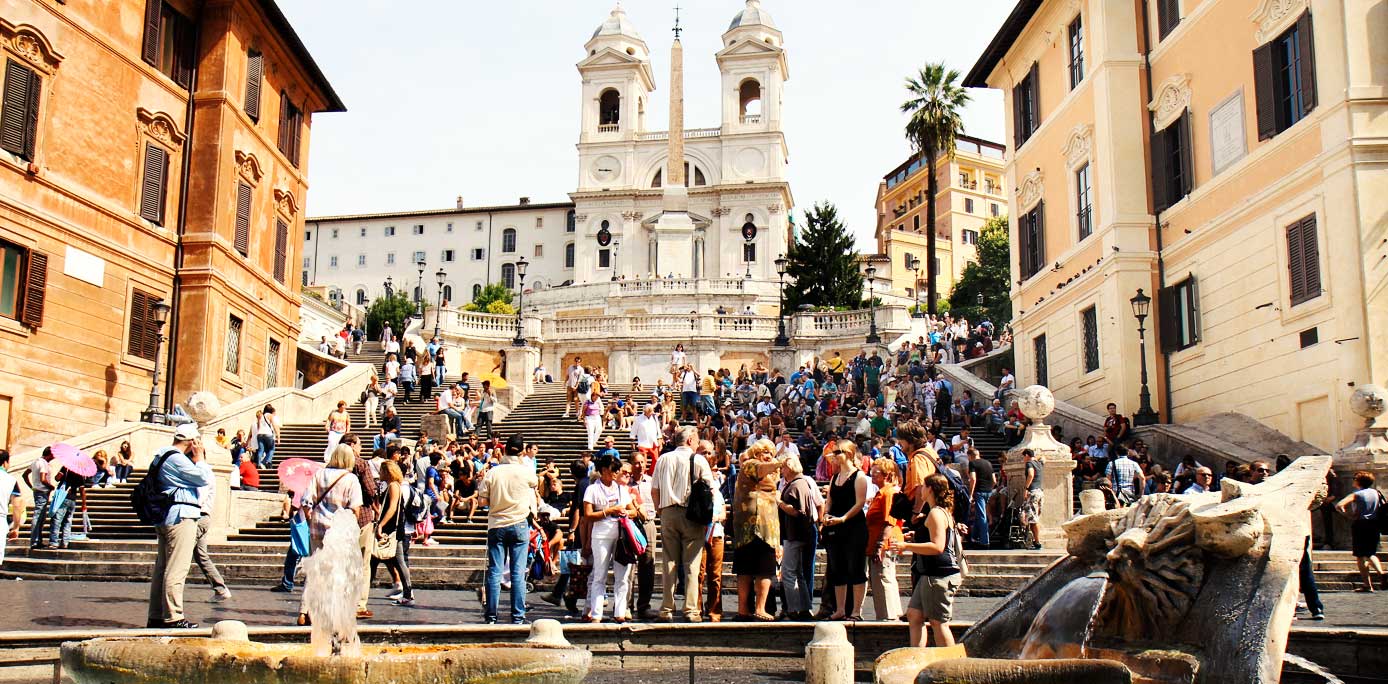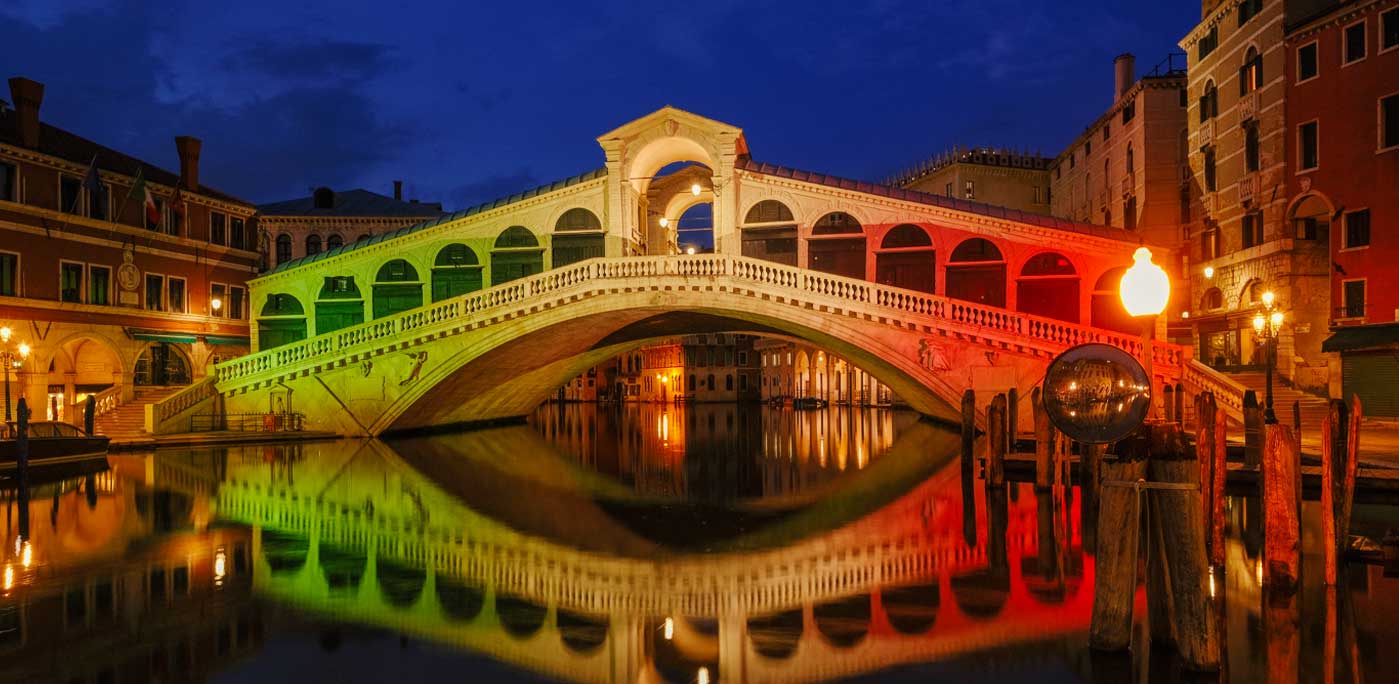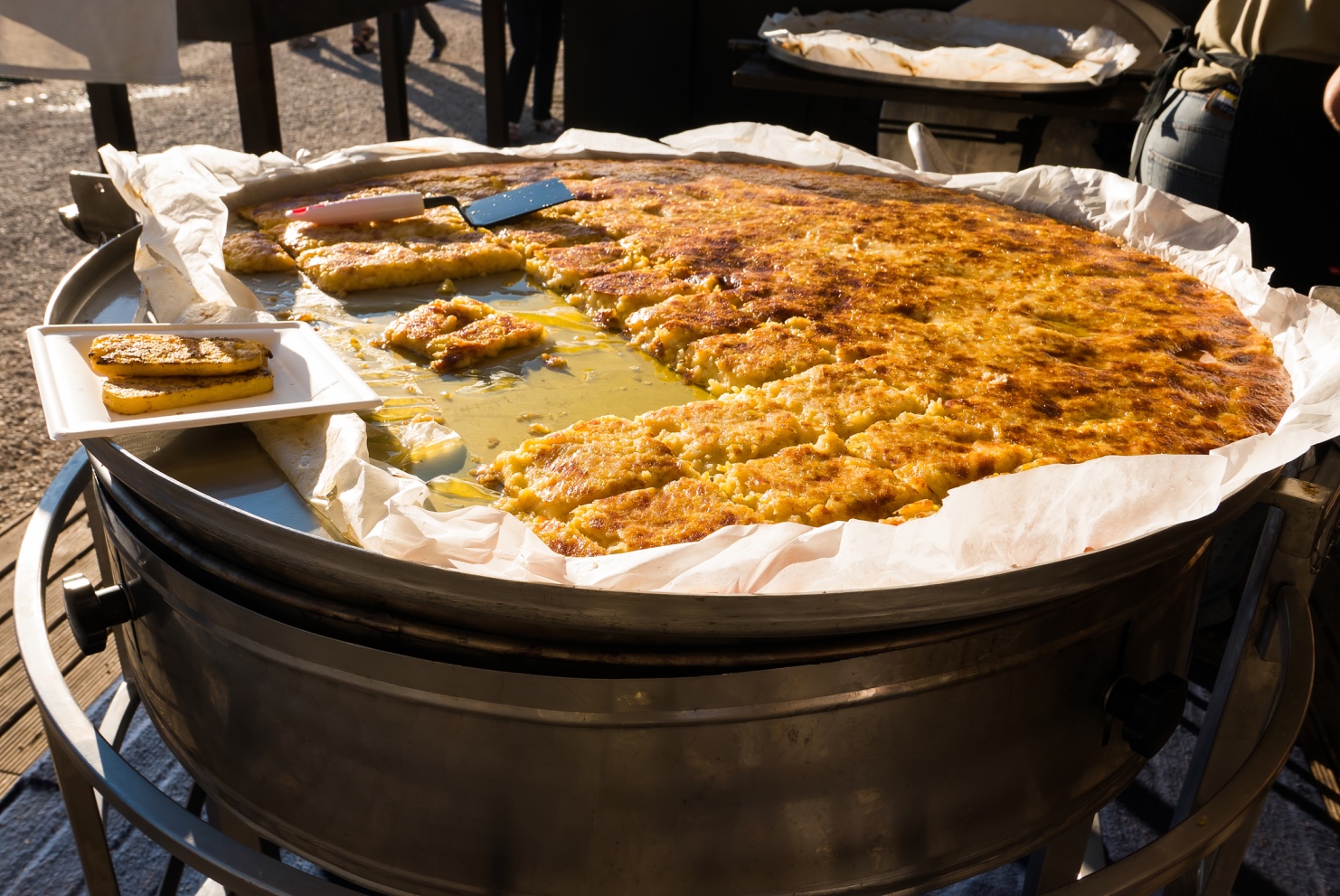Rome: caput mundi, the Eternal City, the cradle of Western culture as we know it (without forgetting Athens, of course!). A city made of history and art, spirituality and, well… controversy.
Those among you who follow the Italian news are aware of the fact our capital has been having it rough recently: a wobbly transport system, severe inefficiencies when it comes to the garbage collection and disposal system, all topped by what many perceive to be too inexperienced a council to regulate the city.
Summer, unlike sleep, does not bring advice, but more issues to solve. In the case of Rome, these issues have a name: tourists.
Tourism is, and always will be, one of the capital’s largest sources of income: visiting Rome is almost a rite of passage, an epiphany for each individual, when the greatness of Humankind, in the shape of art, architecture and the ancient vestiges of the Roman civilization, becomes tangible, visible, truly “real.” And this is without taking into consideration the spiritual relevance of the city.
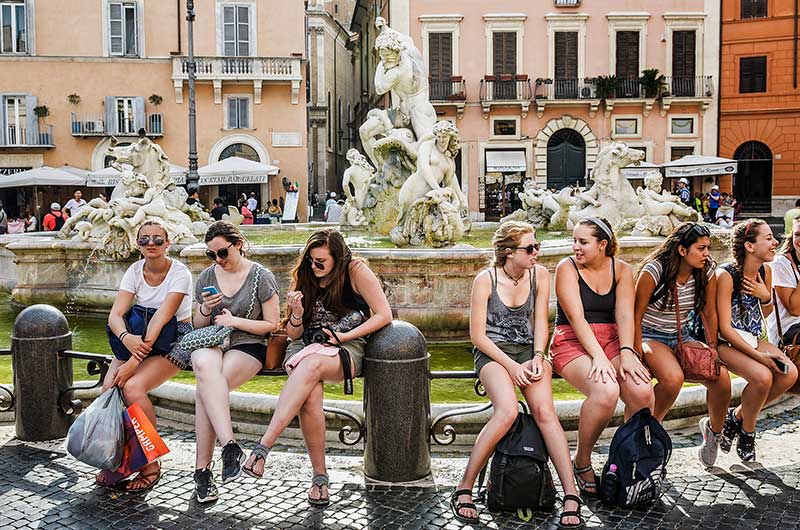
Tourism is, and always will be, one of the capital’s largest sources of income
Yet, as it happened in other popular Italian destinations — namely Florence and Venice — the high numbers of people crowding its streets can become a serious problem, especially when they do not behave properly. Lonely Planet has recently published an article making the point of current and new regulations on the dos and don’ts of holidaying in Rome. Interestingly enough, and in spite of the increasingly high numbers of tourists who’ve been flooding the city in the past decades, city legislations on tourism date back to 1946: basically, they are as old as the Italian Republic.
Rome City Council has recently updated them, with the aim of limiting problems for residents — and for the city’s many monuments — while keeping the value of visitors’ experiences high. Indeed, most of these new rules are more than simple to follow for your average, well behaved tourist: for instance, it is now forbidden to jump into any of the many water fountains populating Roman squares. A lot of people does it, but let’s just say properly mannered individuals know it’s not appropriate. Similarly, penalties have been put into place for men walking around town shirtless: again, if your parents brought you up properly, you should know that no shirt is ok only by the sea. Another bad behavior tackled by the new regulations is that of those ubiquitous “love padlocks,” so popular among teens and locked in places like bridges as a symbol of a couple’s undying love. It may be romantic, but defacing a monument is just not right, not even in name of the most passionate of romances.
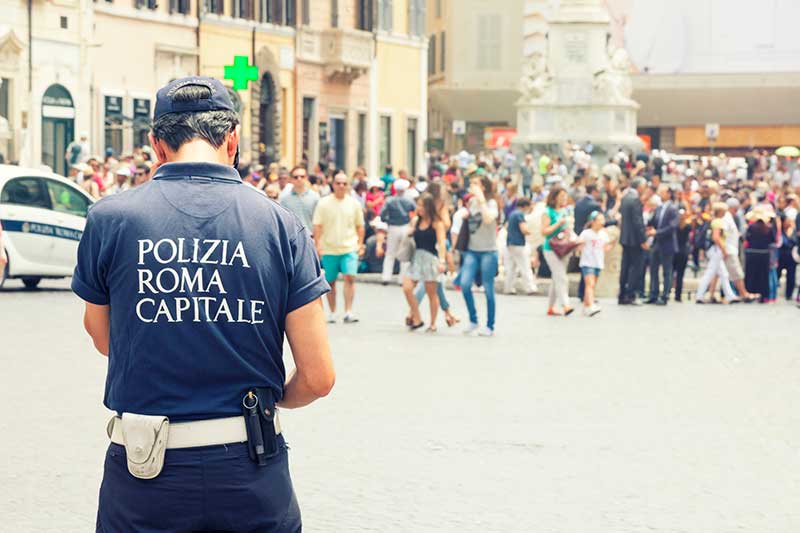
Drinking from Rome’s nasoni, the city’s popular public fountains, will also have new rules: drinking directly from their faucets is no longer allowed
Following the examples of Florence and Venice, which prohibited consuming food in the streets of specific historical areas, having a snack in proximity of some of the capital’s most famous monuments may also be forbidden, all in name of order and cleanliness: now, if only people could respect common, basic rules of civilization and stop littering like mad, we could keep enjoying our gelato and pizza slices walking around without a thought… Drinking from Rome’s nasoni, the city’s popular public fountains, will also have new rules: drinking directly from their faucets is no longer allowed. In other words you cannot touch the fountain with your lips, you’ll have to use your cupped hands to drink or carry with you one of those collapsable plastic cups that were so popular when we were children.
Busking around town, including metro stations, will also be forbidden under new regulations and this may be the one thing visitors and Romans alike will miss: street performers are part of the allure and beauty of places such as London, Paris and Dublin and one could argue that limitations on artistic performance should not be placed. Rome City Council, though, certainly had its own good reasons to take the decision.
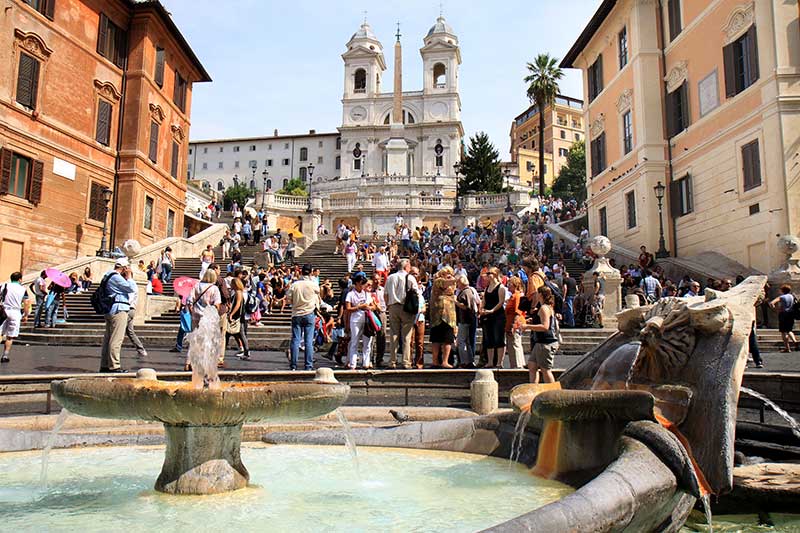
Piazza di Spagna, in Rome. Tourists’ habits around the area may have to change when new regulations are implemented © Wessel Cirkel | Dreamstime.com
Don’t think, however, that Rome’s own new behavioral code only hits the tourists: Romans have to check their manners, too. For instance, they are no longer allowed to hang their laundry to dry between buildings nor can they take prams up and down historical staircases, such as the Spanish Steps.
We are now at the end of June and, while all of the above regulations have been made public, it’s still unclear when and how they will be formally implemented. The point remains the same: are they the right thing to do?
All in all, probably yes. In a world where respect for culture, artistic beauty andspirituality has been getting dangerously low, some stricter rules have become necessary. Ideally, however, everyone should realize that walking around a city shirtless, or entering a church in a bikini — people living by the sea in Italy can confirm that this, indeed, happens — are unacceptable behaviors, just like littering around or sitting on people’ doorstep to eat is. Romans, and polite visitors of the Eternal City, are probably welcoming these new rules with a sight of relief, yet it’s difficult not to consider their presence as a little defeat for Humankind: if we no longer realize what’s unacceptable and disrespectful, then how can we expect to pass on our immense cultural, spiritual and artistic patrimony to the next generations? Welcome, then, are “no-padlock” and “wear-your-shirt-while-in-Rome” rules, if they can help people understand how to behave and respect heritage and beauty.
Roma: caput mundi, la Città Eterna, la culla della cultura occidentale come la conosciamo (senza dimenticare Atene, naturalmente!). Una città fatta di storia e arte, spiritualità e, beh…..problematiche.
Chi di voi che segue le notizie italiane è consapevole del fatto che la nostra capitale ne ha avute alcune recentemente: un sistema di trasporto traballante, gravi inefficienze nel sistema di raccolta e smaltimento dei rifiuti, il tutto sormontato da quella che molti percepiscono come un’amministrazione troppo inesperta per gestire la città.
L’estate, a differenza del sonno, non porta consigli, ma più problemi da risolvere. Nel caso di Roma, questi problemi hanno un nome: turisti.
Il turismo è, e sarà sempre, una delle maggiori fonti di reddito della Capitale: visitare Roma è quasi un rito di passaggio, un’epifania per ogni individuo, quando la grandezza dell’umanità, sotto forma di arte, architettura e le antiche vestigia della civiltà romana, diventa tangibile, visibile, veramente “reale”. E questo senza considerare la rilevanza spirituale della città.
Tuttavia, come è accaduto in altre popolari destinazioni italiane – Firenze e Venezia – l’alto numero di persone che affollano le strade può diventare un problema serio, soprattutto quando non si comportano correttamente. Lonely Planet ha recentemente pubblicato un articolo che sottolinea l’importanza della normativa vecchia e nuova su quel che si può o meno fare durante una vacanza a Roma. È interessante notare che, nonostante il numero sempre più elevato di turisti che hanno inondato la città negli ultimi decenni, le legislazioni cittadine sul turismo risalgono al 1946: in sostanza, sono vecchie quanto la Repubblica Italiana.
Il Comune di Roma le ha recentemente aggiornate, con l’obiettivo di limitare i problemi per i residenti – e per i numerosi monumenti della città – mantenendo alto il valore delle esperienze dei visitatori. Infatti, la maggior parte di queste nuove regole sono più che semplici da seguire per il turista medio e ben educato: ad esempio, ora è vietato entrare in una delle tante fontane d’acqua che popolano le piazze romane. Molti lo fanno, ma diciamo che gli individui ben educati sanno che non è appropriato. Allo stesso modo, sono state previste sanzioni per gli uomini che camminano a torso nudo in città: ancora una volta, se i tuoi genitori ti hanno cresciuto bene, dovresti sapere che solo in riva al mare va bene stare senza camicia. Un altro cattivo comportamento affrontato dalle nuove regole è quello di quegli onnipresenti “lucchetti dell’amore”, tanto popolari tra gli adolescenti e messi in luoghi come i ponti come simbolo dell’amore eterno di una coppia. Può essere romantico, ma deturpare un monumento non è proprio la cosa giusta, nemmeno in nome della storia d’amore più appassionata.
Seguendo gli esempi di Firenze e Venezia, che hanno vietato il consumo di cibo nelle strade di determinate zone storiche, è ora vietato fare uno spuntino in prossimità di alcuni dei monumenti più famosi della capitale, il tutto in nome dell’ordine e della pulizia: ora, se solo la gente rispettasse le regole comuni e basilari della civiltà e smettesse di sporcare di rifiuti all’impazzata, potremmo continuare a gustare il nostro gelato e la pizza a fette senza pensieri….. Anche bere dai Nasoni di Roma, le popolari fontane pubbliche della città, avrà nuove regole: non è più consentito bere direttamente dai loro rubinetti. In altre parole non potete toccare la fontana con le labbra, dovrete usare le mani a coppa per bere o portare con voi una di quelle tazze di plastica pieghevoli che erano così popolari quando eravamo bambini.
Fare gli artisti di strada in città, comprese nelle stazioni della metropolitana, sarà proibito dai nuovi regolamenti e questa potrebbe essere l’unica cosa che mancherà ai visitatori e ai romani: gli artisti di strada sono parte del fascino e della bellezza di luoghi come Londra, Parigi e Dublino e si potrebbe sostenere che le limitazioni alle prestazioni artistiche non dovrebbero essere poste. Il Comune di Roma, però, avrà certamente avuto le sue buone ragioni per prendere questa decisione.
Non pensate, però, che il nuovo codice comportamentale di Roma colpisca solo i turisti: anche i romani dovranno mettere alla prova le loro buone maniere. Ad esempio, non potranno più appendere il bucato ad asciugare tra gli edifici, né portare carrozzine su e giù per le scale storiche, come la scalinata di Trinità dei Monti.
Ora siamo alla fine di giugno e, sebbene tutte le norme di cui sopra siano state rese pubbliche, non è ancora chiaro quando e come saranno attuate formalmente. Il punto rimane lo stesso: sono la cosa giusta da fare?
Tutto sommato, probabilmente sì. In un mondo in cui il rispetto per la cultura, la bellezza artistica e la spiritualità si sta pericolosamente abbassando, sono diventate necessarie regole più severe. Idealmente, però, tutti dovrebbero rendersi conto che camminare per una città a torso nudo, o entrare in chiesa in bikini – la gente che vive al mare in Italia può confermare che questo, in effetti, accade – sono comportamenti inaccettabili, proprio come lo è buttare spazzatura in giro o stare seduti a mangiare sulla porta di casa di qualcuno. I romani, e i visitatori educati della Città Eterna, stanno probabilmente accogliendo queste nuove regole con uno sguardo di sollievo, ma è difficile non considerare la loro esistenza come una piccola sconfitta per l’umanità: se non ci rendiamo conto di ciò che è inaccettabile e irrispettoso, allora come possiamo aspettarci di trasmettere alle generazioni future il nostro immenso patrimonio culturale, spirituale e artistico? Benvenute, dunque, sono le regole del “no-lucchetti” e del “porta-la-camicia-in-giro-per-Roma”, se possono aiutare le persone a capire come comportarsi e rispettare il patrimonio e la bellezza.



